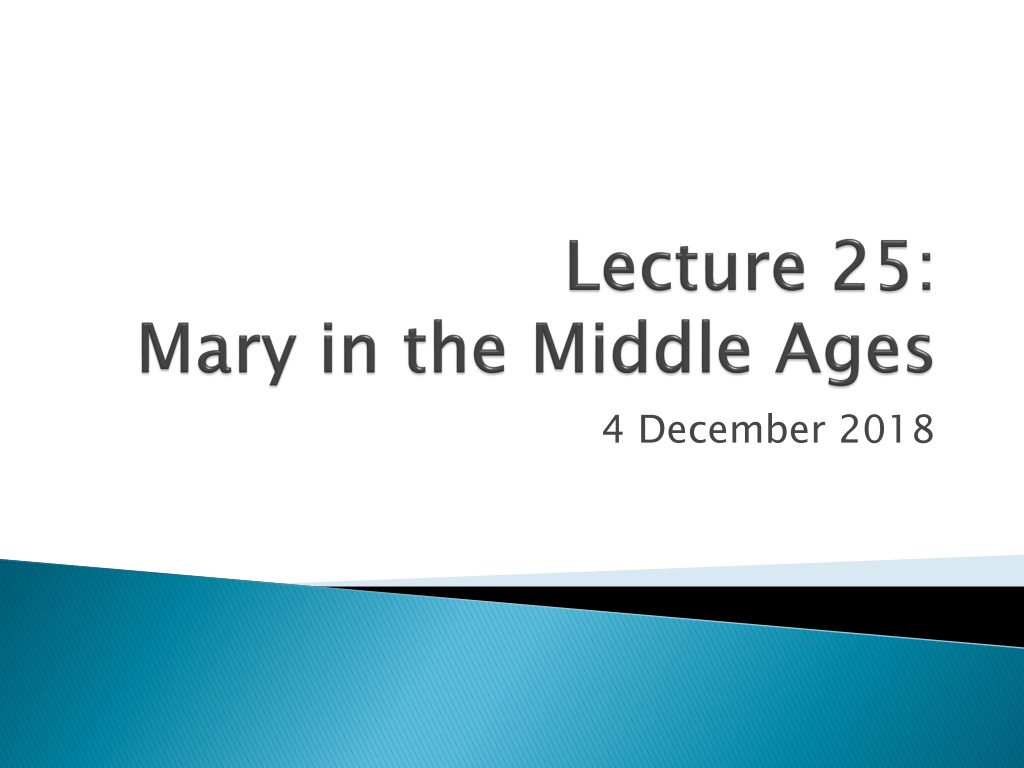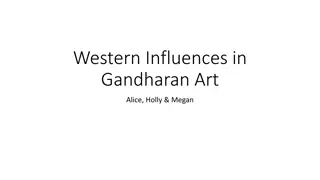Influence of Mary in Byzantine and Western Art Through the Ages
The influence of Mary, the mother of Jesus, in Byzantine and Western art is explored through various historical events and artworks. From early visions of Mary to the declaration of Feast of Dormition, the devotion to Mary has shaped artistic representations and church dedications. Iconic cathedrals like Chartres Cathedral and the presence of important relics like the Sancta Camisa in Europe underline the significance of Mary in religious art and culture.
Download Presentation

Please find below an Image/Link to download the presentation.
The content on the website is provided AS IS for your information and personal use only. It may not be sold, licensed, or shared on other websites without obtaining consent from the author. Download presentation by click this link. If you encounter any issues during the download, it is possible that the publisher has removed the file from their server.
E N D
Presentation Transcript
Mary in the Greek East and influences in West Chartres Cathedral Advent Liturgy Mary and the Saints
Based on Luke and John St Gregory of Thaumaturgas (3rdC) has a vision of Mary and John the Baptist Reinforced at Council of Ephesus (431) Feast of Dormition officially declared as 15 August at end of 6thC by Emperor Maurice and Pope St Gregory the Great Most important icon in Constantinople was image of Mary painted by St. Luke
It is likely that representations of Mary found in Byzantine art in Italy influenced Romanesque (Cluny) representations of Mary Returning pilgrims encouraged a devotion to Mary St. Bernard of Clairvaux profoundly influenced by Eastern understanding of Mary In Divine Comedy, Dante the pilgrim is shown a vision of Mary by St. Bernard By 12thC, almost all great churches were devoted to Mary
One of the most beautiful of all the gothic cathedrals was dedicated to Mary After Chartres, most of the great cathedrals were dedicated to Mary Chartres was important place of pilgrimage Our Lady s tunic Seat of Wisdom statue
Chartres possesses the most important Marian relic in Europe: the Sancta Camisa According to legend, Mary wore the tunic at the Annunciation and at the Nativity Chartres came into possession of the tunic through Charlemagne s grandson, Charles the Bald in mid-9thC
The Life of Charlemagne, Chartres According to The Pilgrimage of Charlemagne (mid-12thC) (aka The Merry Pilgrimage) Charlemagne went on a pilgrimage to Jerusalem Returning through Constantinople, the Emperor Nicephorus and Empress Irene gave the Sancta Camisa to Charlemagne to honor him as HRE Upon his return, Charlemagne had the tunic in a reliquary in Aachen NB There is also a 11thC legend that Alfred the Great (849 899) went on a pilgrimage to Jerusalem
Mary, the Seat of Wisdom St. Peter Damien (d. 1073) referred to Mary this way, comparing her to the throne of Solomon Famous early Medieval wooden statue of Mary seated, holding Jesus at Chartres Became a common statue throughout Medieval France and Spain
Chartres located on a high plateau over looking the Christianized as a result of conversion of Clovis Chartres quickly became an important ecclesiastical center Important economic center (equal or more so than Paris) in the 5 Pepin the Short refers to the Church of Mary and its bishop as being strong allies against Merovingians In 911 Chartres attacked by Vikings led by Rollon According to legend, the bishop brought the Sancta the Vikings were converted to Christianity Rollon province of Normandy Normandy remained under the patronage of the bishop of Chartres throughout the Middle Ages Chartres located on a high plateau over- - looking the Eure Christianized as a result of conversion of Clovis Chartres quickly became an important ecclesiastical center Important economic center (equal or more so than Paris) in the 5th Pepin the Short refers to the Church of Mary and its bishop as being strong allies against Merovingians In 911 Chartres attacked by Vikings led by Rollon; ; According to legend, the bishop brought the Sancta Camisa the Vikings were converted to Christianity Rollon became the first duke of the new province of Normandy Normandy remained under the patronage of the bishop of Chartres throughout the Middle Ages 14thC Manuscript of Rollon Conversion at Chartres Eure River River th 10 10th thC C Camisa to the ramparts, upon seeing it, to the ramparts, upon seeing it, became the first duke of the new
Begun (according to legend) by Alcuin of York under Charlemagne Specialized in the quadrivium: arithmetic, geometry, music, astronomy Mathematics Commentaries on Boethius and his commentaries on Pythagoras and Plato s Timaeus Key scholar was Bishop was Fulbert (970 - 1028) Encouraged use of Arabic numerals Encouraged careful astronomical observations Bishop Fulbert at Chartres Pythagoras at Chartres
In 1020 the cathedral completely destroyed by fire; but the Sancta Camisa was saved. Fire broke out on eve of Mary s Nativity Fulbert collected money, hired architects and assisted in design of new cathedral Died before completed Another 11thC fire destroyed some of Fulbert s original design Chartres was the most important Gothic Cathedral Architecture (flying buttresses) Statues Stained glass
Rebuilding Chartres became an act of spiritual penance for those engaged in the work. Recognized at the time as a new type of spirituality and prayer Known as the legend of the carts Mary of Mercy was petitioned to intercede for The forgiveness of sins The return to health Safety of travelers and crusaders A new type of pilgrimage and the story of the carts People from across Europe came to Chartres to work on the Cathedral Usually bringing own tools and arriving in carts Participants included rich and poor, men and women Chartres became a monument to these working pilgrims Common man/woman personal history within the over-all context of salvation history Mary of Mercy became the queen of history Carts of Workers at Chartres
First indication of Advent as a special liturgical season is from St. Gregory of Tours (538-594) in his life of St. Martin (316-397) It seems from the mid-5thC a time of fasting and prayer was observed in Frances from St. Martin s Feast Day (Nov 11) until Christmas The observance of Advent varied by location and bishop to between 5 and 7 weeks. Early Advent liturgies developed at Charlemagne s court Pope St. Gregory VII seems to have been the first to formalize Advent at 4 weeks.
Joachim and Anne Bring Mary to Temple From 10thC (at least) four Marian feasts celebrated at Chartres: Mary s Nativity (Sept. 8); Annunciation (March 25); Purification (Feb. 2) and Assumption (15 August) In Chartres, celebrated as a Marian cycle summarizing salvation history Fulbert and his disciples wrote offices, hymns and homilies Fulburt first to use Protevengelium of James liturgically for Mary s Nativity NB Mary s nativity is mentioned in the Qur an
Seems to have been a special cycle of Marian liturgies at Chartres between he nativity and the beginning of Advent Advent was (is) a time to especially consider history from Creation to the Parousia First Sunday: Adam to Noah Second Sunday: Noah to Moses Third Sunday: Moses to Christ Fourth Sunday: Nativity to Parousia Expanded at Chartres to include an emphasis on Virgin and her role in salvation history Tree of Jesse
In later Middle Ages, Chartres reduced in importance compared to Paris Associated too closely with Carolingians rather than Capetians Charter school did not develop into a university During the French Revolution, Chartres Cathedral was attacked, but not seriously damaged However, the Sedes sapientiae was destroyed Bronze Center of Labyrinth, along with the bells was taken and melted for Napoleon s canons During WWII Glass removed from Cathedral Nearly destroyed in summer of 1944 by Americans, fearful that Chartres was being used by German Army Currently, massive cleaning and restoration underway; but very controversial. See NY Times article Sept. 1, 2017.

 undefined
undefined





























